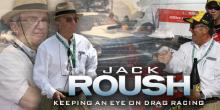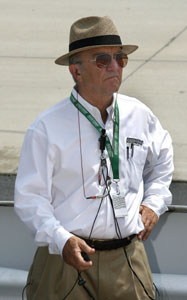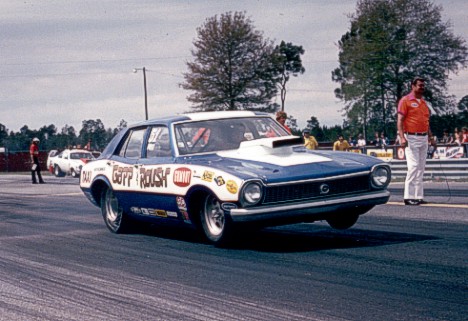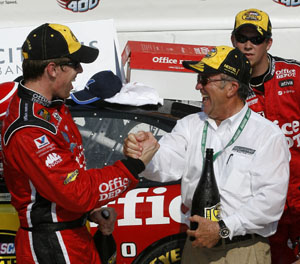FIRMLY IN NASCAR, ROUSH KEEPS AN EYE ON THE DRAGS
 achieved success by being a visionary.
achieved success by being a visionary.Drag racing, it turns out, is his inspiration.
He's well beyond the romance of sniffing nitro fumes and being tongue-tangled trying to describe header flames during Friday-night qualifying. Roush thinks of dragsters and Funny Cars and his imagination soars into the realms of medical technology and extraterrestrial energy solutions.
"If the hospitals, with all of their medical science, could find a way to put somebody in a tube and blow him out to a dragstrip whenever a Top Fuel dragster or a Funny Car is getting ready to make a pass, it would have a rejuvenating effect more than the electric shockers they put on your chest when your heart stops," he said.
Jack Roush, one of NASCAR's premier team owners and the Ford Motor Company's shining star in the auto industry's dark sky, has  achieved success by being a visionary.
achieved success by being a visionary.
Drag racing, it turns out, is his inspiration.
He's well beyond the romance of sniffing nitro fumes and being tongue-tangled trying to describe header flames during Friday-night qualifying. Roush thinks of dragsters and Funny Cars and his imagination soars into the realms of medical technology and extraterrestrial energy solutions.
"If the hospitals, with all of their medical science, could find a way to put somebody in a tube and blow him out to a dragstrip whenever a Top Fuel dragster or a Funny Car is getting ready to make a pass, it would have a rejuvenating effect more than the electric shockers they put on your chest when your heart stops," he said.
"To stand on the starting line and to watch a Top Fuel car or a Funny Car do a burnout -- or even stand behind a Pro Stock car today and listen to what's going on in that equipment, there's a level of excitement, a level of percussion," Roush said. "I believe that if there's life someplace else in the universe that could look down and see what's going on, I think they would find a unique energy source in what happens at our dragstrips that would go across millions of miles."
And here some people thought of drag racing merely as two cars, two drivers, two lanes, and one goal -- to get to the finish line quicker.
Ah, but it is that, too . . . simple concept, a simple blueprint. For Roush it was "the foundation of my racing experience." He spent the first 15 years of his motorsports career as a straightliner and said that "the judgments I use as related to sanctioning bodies, the judgments I use as related to people, not only how you interact with people on a team of your own but how you interact with others when you're in the contentious environment that you're in. All the morays, all the ground rules . . . are related to drag racing and the habits I built there."
If the hospitals, with all of their medical science, could find a way to put somebody in a tube and blow him out to a dragstrip whenever a Top Fuel dragster or a Funny Car is getting ready to make a pass, it would have a rejuvenating effect more than the electric shockers they put on your chest when your heart stops.
a d v e r t i s e m e n t
Click to visit our sponsor's website
Those who have followed drag racing since its inception remember well the 1971-76 Gapp and Roush Pro Stock team, featuring former

Roush won at the U.S. Nationals in 1972 in his Super Stock class' 24-car field, driving an entry he had built and was campaigning for the first time. The car, he said, was "built with parts I had left over from 10 years of racing."
Canadian Barrie Poole, the first north-of-the-border racer to win a major trophy in a U.S. drag race, was a buddy of Roush's. And Roush counts his relationships with Ed Iskanderian, Harvey Crane, Vic Edelbrock, and Fred Carrillo among his favorite memories in the sport that gave him his start in racing.
That start, Roush said, was an economic decision as much as anything.
"Drag racing was all I had the money to do as I got started, all I had the money for," he said.
Calling Wally Parks, the father of organized drag racing, "a timeless institution on the American scene," Roush credited him for his own big leap.
"I almost certainly wouldn't have had the same approach toward racing if I hadn't had the chance with Wally and his organization."
What started it all was the group of folks he quickly gravitated to when he started working for Ford in 1964. It included engineers, purchasing agents, public-relations representatives, a production-control specialist, and even a nuclear physicist.
"Ten guys were putting their money together -- $45 a month -- and with the help of local Ford dealers, we raced all over the country with our Ford Galaxy and our Mustang in the early days," Roush said. "I followed that from the Stock and Super Stock ranks to the Pro Stock ranks, then ultimately helped other people and a number of other cars in the open-wheel category.
Roush sold NHRA dominator Bob Glidden his first Pro Stock car.
"It was a car that I had in 1972, that I raced with my Super Stock car," Roush said.
"I often enjoy telling the story..." Roush said. "Before I started with the Fastbacks (the group of 10 from Ford) in 1966, I made a partnership with one fellow. We built a 1960 Falcon with a 289 high-performance engine in it. I raced it for two and a half years all over the Eastern United States, from North Carolina to Michigan, Ohio, and Illinois. For two and a half years, I never lost in my Falcon. We re-created that car, and it was one of the cars we had on that dragstrip" three years ago.
Roush even got behind the wheel, though daughter Susan Roush-McClenaghan (of National Mustang Racing Association notoriety) is the one he calls "the most able among our drag-racing family today." It put him on the "injured-reserve list" for nearly a month, roughing up his body after dealing with detached rotator cuffs in both shoulders.
"I had my shoulder hurting for about three weeks," he said. "I'm sure the kids wondered, 'Why doesn't Dad want to get back in the car. Do you think we frightened him?'” The answer is no, but Roush said, "I'm too old and too decrepit probably to do it today."
(Citing Chris Karamesines as an example, Roush acknowledged that drag racing is a sport that knows no real age limits. "He was in his 50s when I was 20, and I'm 60 now! Guess that's the new math," he said with a laugh.)
a d v e r t i s e m e n t
Click to visit our sponsor's website

Roush-McClenaghan, who competes in the Open Comp class, last month became the first woman to win a street-legal drag race, capturing the NMRA/NMCA Super Bowl of Street Legal Drag Racing event at Joliet, Ill.'s Route 66 Raceway. She won the Shootout portion of the event, as well, against NMRAs Open Comp event winner Paul Leaman.
She also reached the final round in the March NMRA season-opener at Bradenton Motorsports Park in Florida. At this year's Daytona 500 festivities, she had on display her 2001 Roush Stage 3 Mustang that was converted to a drag-racing car after its use as a calibration-development vehicle by the Roush engineering group.
So even though her dad promised he might slide back into a drag-racing car if his shoulder healed, she is the family's best hope for the 1320-feet set.
Dad is plenty busy today, keeping up with what's going on with NASCAR Sprint Cup drivers Carl Edwards, Greg Biffle, Matt Kenseth, Jamie McMurray, and David Ragan. In addition, he oversees his own Roush Industries conglomerate that fills 59 buildings and employs about 3,000 workers. But he took time awhile ago -- although he has just two free weekends between early February and Thanksgiving, he said -- to spread the gospel of drag racing.
At the invitation of team owner Don Prudhomme, Roush brought some of this NASCAR-team associates to Maple Grove Raceway at Reading, Pa., when the stock cars were at Dover, Del., the same weekend. And said Roush, "If you could take some of the folks who are excited about NASCAR and go stand them on the starting line and let them watch what's going on there, they would have a new appreciation and there would be more drag-racing fans among the folks who are NASCAR and Indy-car fans."
He has ventured to Michigan's Milan Dragway many a Wednesday night with his family for the test-and-tune activity, declaring the sport "a great opportunity for families" and "a great place to get started."
While going from late afternoon to about 10 o'clock at night, Roush said he sees "all the Junior Dragster and all the young families. There are grandfathers out there I raced against who are helping their grandkids today. It makes me feel old."
If NASCAR is ever to catch up to drag racing with its diversity, it's "going to have to permeate our society," Roush said. "NASCAR can't fix it. The teams can't fix it. Families and broader American society have got to decide that's what they want to encourage their kids to do. That is the challenge.
"I won't say it's easier to drive drag cars than it is to drive NASCAR cars, because I don't believe that's true. But the thing that is true is that when folks are growing up, families expose their kids more to drag racing than they do to stock-car racing," he said.
"Stock-car racing grew up in the Southeast. It was primarily a white-male-dominated sport. It was a gentleman's game among guys who weren't too sophisticated and probably didn't have a better-than-average education. So they were out there doing their thing and attracting great attention in the news and the boardrooms and they said, 'OK -- we can sell sponsorships and make it work.' But there hasn't been the grassroots support from families . . . to get their kids involved," Roush said.
"If whites, Hispanics, blacks, and women will come to us with credentials to be able to do what we need to do," he said, "then there'll be plenty of room for them."
America's development of racing in all forms is based on our status as a free society.
"When drag racing got started after World War II in the United States, it was a time of booming economy, when we brought back the young people who were off to the war. They had money to spend on things, and they wanted to do exciting things," Roush said. "All of our manufacturing capabilities were intact, and we were able to start new things for consumers without trying just to rebuild our infrastructure, as was the case in Japan and Europe.
"We've had a chance in this country, based on what our fathers and grandfathers -- I'm speaking about my generation -- to really be able to enjoy the good life and go out there and be sports-minded," he said. "In most parts of the world, you couldn't have that much disposable income to be able to do those things."
He said both the NHRA and IHRA "are great organizations. They give people the chance to work on things in their garages at home. There probably are people who still race cars that will have their mufflers hooked up and will drive to the racetrack and change the tires and run the car on the track."
That was Jack Roush's world years ago. It's part of what shaped him into the motorsports mogul he is today. And with his imagination -- his imagineering? His love for drag racing might inspire him to design the future of racing.
| {loadposition feedback} |




